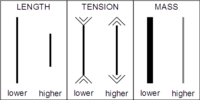Mersenne's laws

Have you ever counted your fingers and realized that you have 10 of them? That's a kind of math called arithmetic. But, there are other kinds of math that deal with really big numbers, like those with hundreds or thousands of digits. One of those types of math is called "number theory," and it's all about studying patterns and relationships between numbers.
One of the most famous mathematicians in history is named Marin Mersenne, and he loved studying number theory. He discovered something really interesting about some numbers that have a specific form, called "Mersenne numbers." These are numbers that can be written as 2 to some power minus 1, like 3, 7, or 31 (because 2 to the power of 2 is 4, minus 1 is 3; 2 to the power of 3 is 8, minus 1 is 7; and so on).
Mersenne noticed that for a Mersenne number to be prime (which means it can only be divided evenly by 1 and itself), the power that you use to get 2 needs to be a "prime number" too (a prime number is a number that can only be divided evenly by 1 and itself, like 2, 3, 5, 7, 11, and so on).
For example, 2 to the power of 7 is 128, minus 1 is 127. 127 is a prime number, which makes 2 to the power of 7 minus 1 (aka, 127) a Mersenne prime. Mersenne found 17 Mersenne primes (so far), but they get harder and harder to find as the power gets bigger and bigger.
Mersenne's laws help us understand the patterns of these Mersenne primes and how they are related to other prime numbers. By studying these laws, mathematicians can better understand some of the most complex and fascinating aspects of number theory.
One of the most famous mathematicians in history is named Marin Mersenne, and he loved studying number theory. He discovered something really interesting about some numbers that have a specific form, called "Mersenne numbers." These are numbers that can be written as 2 to some power minus 1, like 3, 7, or 31 (because 2 to the power of 2 is 4, minus 1 is 3; 2 to the power of 3 is 8, minus 1 is 7; and so on).
Mersenne noticed that for a Mersenne number to be prime (which means it can only be divided evenly by 1 and itself), the power that you use to get 2 needs to be a "prime number" too (a prime number is a number that can only be divided evenly by 1 and itself, like 2, 3, 5, 7, 11, and so on).
For example, 2 to the power of 7 is 128, minus 1 is 127. 127 is a prime number, which makes 2 to the power of 7 minus 1 (aka, 127) a Mersenne prime. Mersenne found 17 Mersenne primes (so far), but they get harder and harder to find as the power gets bigger and bigger.
Mersenne's laws help us understand the patterns of these Mersenne primes and how they are related to other prime numbers. By studying these laws, mathematicians can better understand some of the most complex and fascinating aspects of number theory.
Related topics others have asked about:
